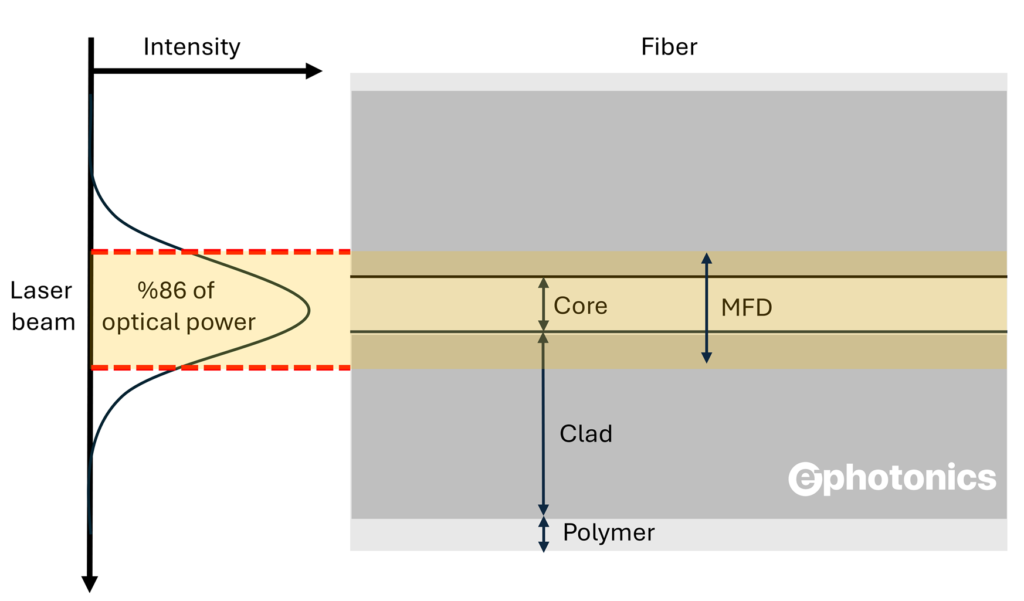Within optical fiber technology, the Mode Field Diameter (MF) is the term used to define the effective width size of the light-carrying core in single-mode fiber. While in multimode fibers multiple light paths are being guided, in single-mode fibers, only one mode of light is transmitted. MFD is very important in order to understand how light is propagating through the core, since this makes great effects on the fiber performance concerning signal transmission, its efficiency, and coupling to other optical components.
FMFD is not the diameter of the physical core of the fiber but instead refers to the area of the fiber within which a high percentage of the light traveling through the fiber’s intensity may lie. It is normally measured by determining the distribution of a light field whereby about 86% of the total optical power exists in. Therefore, MFD provides a decent approximation for the power distribution of light in the core, considering the smooth decaying at the edges of the light. A figure below is given to illustrate a mode field diameter in fiber.

MFD will directly impact the efficiency of how the light couples from one fiber to another or from a laser source into the fiber. A good match in MFD between two fibers or between a fiber and a laser source will result in lower losses and better transmission quality. Poor alignment of MFD ratios between two fibers can lead to considerable coupling losses and negatively affect the efficiency of the overall system.
The MFD also further links to attenuation and dispersion, important in establishing the extent to which data can be transmitted over long distances through an optical fiber. With a larger MFD, one may expect a generally lower attenuation, since more light is spread out over a wide area, its interactions with the boundary of the core, where losses are likely to occur, become less. On the other hand, smaller MFDs at times lead to higher losses resulting from tight confinement of light.
The beam divergence exiting the fiber is determined by the MFD of the fiber itself. Fibers with larger MFDs will exhibit lower divergence angles and are therefore suitable for fiber lasers or other sensing applications where light beams must be controlled tightly.
The Mode Field Diameter in single-mode optical fibers can be approximated using the following formula:
$$\text{MFD} \approx \frac{2 \lambda}{\pi \cdot \text{NA}}$$
where $ \lambda $ is wavelength and NA is numerical aperture of fiber. This approach provides a rough estimate, in which MFD is directly related to the wavelength and NA of the fiber. For instance, with larger MFD, the light field is more spread around, and hence it may improve the efficiency of coupling with probably increased bending losses.
Dietrich Marcuse’s equation gives more precision and can be applied to the application areas where the design or application calls for precise values of the fiber. Marcuse’s equation refines MFD with only two parameters, core radius, and refractive index difference of the fiber:
$$
\text{MFD} \approx 2a \sqrt{\frac{0.65 + 1.619 V^{-1.5} + 2.879 V^{-6}}{\pi}}
$$
where $ a $ is the core radius, and $ V $ is the normalized frequency parameter, given by
$$
V = \frac{2 \pi a}{\lambda} \cdot \text{NA}
$$
MFD is usually measured by two main techniques: far-field scanning and near-field scanning.Far-Field Scanning technique detects the light pattern exiting the fiber and measures the MFD by the intensity decay away from the core center. The Near-Field Scanning technique needs measurements over the light pattern close to the end of the fiber. It allows calculating MFD more precisely but needs special equipment.
Sometimes, MFD is confused with the physical core diameter of a fiber; although core diameter refers to the real core size, MFD explains that region where the light energy is most and this region extends out of the core because the decay in intensity is gradual, and hence MFD is generally slightly larger than the core diameter, especially in single-mode fibers. You could see the figure given above for better imagination.
The mode field diameter basically constitutes the fundamental theory behind single-mode optical fibers. It forms the core understanding of the light propagating and its interaction within the fiber. This directly influences transmission quality, coupling efficiency, and signal loss. As such, it is one of the most important parameters for those people dealing with fiber optics. You can calculate mode field diameter online using our mode field diameter calculator, or otherwise, you can also see our photonics calculators page for any other photonics-related calculators.
Join our newsletter to stay updated with new articles and news!

ephotonics is a go-to partner for photonics solutions, with deep expertise in laser electronics and laser design. We’re committed to delivering effective solutions for laser-based applications and sharing helpful articles. To learn more about us, check out our About page.